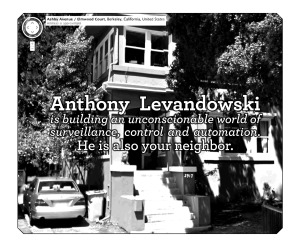“People like [Anthony] Levandowski are gentrifying neighborhoods, flooding the market with noxious commodotities, and creating the infrastructure for an unimaginable totalitarianism.”
–The Counterforce [1,2]
A group referring to themselves as The Counterforce has escalated tactics by staging a home demo at the Berkeley home of Google employee Anthony Levandowski and leafletting his neighborhood. Initially the dispute that Counterforce has dramatically entered focused on two things: (1) private luxury buses operated by Google and other tech companies are making illegal use of public bus stops, effectively appropriating a public good; and (2) the gentrifying effect that the tech industry’s workforce has on the city of San Francisco. Activists have been physically blocking Google buses at public bus stops as a means of registering their complaint.
While still pressing these grievances, Counterforce has added a third, more ambitious, objection. It is Google’s vision of the future—exemplified in the work of Anthony Levandowski—and the company’s collaboration with the government’s military and surveillance efforts. They have shifted from the micro to the macro. The conversation is deliberately being shifted from whether to Google should pay a small fee for use of public infrastructure to their role in “creating the infrastructure for an unimaginable totalitarianism.”
Why Levandowski?
Critics of the Counterforce action have correctly pointed out that Google’s future prospects do not hinge in any real way on Levandowski. He is a high level employee who has played the lead role in the company’s driverless car program but is certainly not critical in any sense. He is not the CEO and even if he was the same criticism would apply: CEOs are no less disposable.
A fine grade division of labor and the notion of corporate personhood serves to dilute personal responsibility to its vanishing point. In some sense, no one at Google is responsible for what Google does. Activists are therefore confronted with a rigged shell game. To pick someone out of the crowd may seem unfair and yet this particular crowd is a real danger. Hannah Arendt explains that “The trouble with Eichmann was precisely that so many were like him…terribly and terrifyingly normal.” Consequently one might be tempted to ask: “Why Eichmann?”
Levandowski may have appeared on Counterforce’s radar due to a lengthy profile that appeared in The New Yorker last November detailing his efforts to bring Google’s driver-less car to market. Indeed, the flyer Counterforce distributed in Levandowski’s neighborhood is prefaced with a quote from Levandowski that appears in The New Yorker article: “My fiancee is a dancer in her soul. I am a robot.”
The generally praiseworthy article describes Levandowski as “equal parts idealist and venture capitalist. He wants to fix the world and make a fortune doing it”. He is described as someone who “just has more faith in robots than most of us do” with a “gift for seeing through a machine’s eyes”
It is not likely that Levandowski was targeted because he is unique amongst his Google colleagues; on the contrary, he was likely targeted because he is emblematic. Many of his colleagues will not be able to help but realize that they could have just as easily been selected and exposed and shamed. For activists to pick somebody out of the crowd and detail their role, connect that particular set of dots, is effectively to indict every person in a similar role.
As an added incentive for selecting Levandowski is the fact that he has ambitions to build luxury condos and therefore contributes to the gentrification of San Francisco in a significant way. This makes Counterforce’s choice relevant to all three grievances currently being fought over.
Furthermore, Levandowski has been financially rewarded for his contributions to realizing a fully-automated future; there is no reason why he should not also experience some negative social feedback from those who disapprove of his Google endorsed worldview.
Why Home Demos?
Home demos have been employed by activists committed to various causes including animal liberation as well as anti-abortion efforts. They are disparaged by many but have often produced results.
A 2011 article in Society & Animals quotes an activist with experience participating in home demos who explains that not only is it an effective tactic but “it doesn’t take a lot of resources and it doesn’t take a lot of people”. Reports are not entirely clear but the demo at Levandowski’s residence may have been carried out by as few as ten people and lasted less than an hour in duration yet it has already garnered media attention in the Los Angeles Times, the San Francisco Chronicle, Berkeleyside and a host of publications that specifically cover the tech industry. Silicon Beat wrote that “[a]ll this controversy couldn’t have come at a worse time for tech” which is another way of saying it couldn’t have come at a better time.
Ironically, one of Levandowski’s neighbors complained about the demo saying that “homes are supposed to be a safe place.” Ironic because part of the impetus for the demo was the gentrification of San Francisco caused by people like Levandowski which will result in many less financially well off individuals being displaced from the homes altogether. In fact, for those without money, homes have never been such a safe space. Failing to pay one’s rent or mortgage means that a person may be evicted as gunpoint if need be. If the state finds one guilty of committing a crime, home is not a safe space, again a person will be dragged out.
It would be more accurate to say that those with money such as Levandowski are able to use private property—be it their homes or other property—to maintain a buffer between them and the consequences of their actions. Activists staging home demos are working to breach that buffer and bring the harm of their actions to their neighborhood.
In the meanwhile, the future is already taking hold. Levandowski says that to his three year old child, Adam, “everything’s a robot”.


